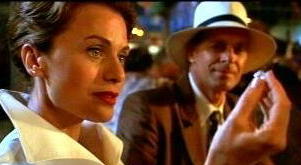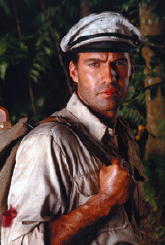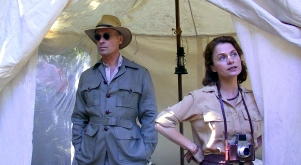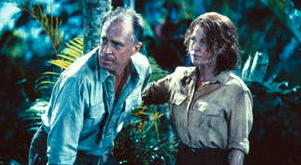Wed 28 May 2008
Movie Review – THE DIAMOND OF JERU (2001).
Posted by Steve under Reviews , Suspense & espionage filmsNo Comments
THE DIAMOND OF JERU. Made for cable TV (USA), 2001. Billy Zane, Paris Jefferson, Keith Carradine, Jackson Raine. Based on a story by Louis L’Amour. Teleplay by Beau L’Amour [also co-executive producer]. Directors: Ian Barry, Dick Lowry.

This movie has come up once before on this blog. It was back here, when I reviewed Off the Mangrove Coast, the Louis L’Amour collection where you can read the story the film was based on.
Here’s the relevant portion of what I had to say back then:

This one’s the latter. Billy Zane plays Mike Kardek, the guide first hired by Helen and John Lacklan (Paris Jefferson and Keith Carradine), only to be fired when Mr. Lacklan thinks something is going on between Kardek and Mrs. Lacklan. (Eyes only, nothing more. Nor anything less, for that matter, and sometimes it does.)
Paris Jefferson, by the way, played the goddess Athena in the Xena television series just before her role in this movie. She has one of those faces that seems to change when viewed from different directions and in different contexts and scenes. I’ve found a number of shots taken from the movie to help illustrate. I do not know why this is the last movie she seems to have made.
Kardek is an American adventurer down on his luck and stranded in Borneo with no funds to make the trip back home. The year is 1955. I was going to say “rugged American adventurer,” but he’s too good-looking to be able to say that with a straight face.
Mr. Lacklan is an atomic scientist from the lab in Los Alamos, New Mexico, the kind of guy that thinks that saying he is an American will pave his way into being allowed to do anything he wants anywhere in the world.
Mrs. Lacklan is too much of a restless spirit to stay cooped up in such an isolated community, and boredom has begun to creep into their marriage. One solution: a trip to Borneo to find a diamond to fit the (deliberately) empty spot in her wedding ring. She also reads books, one way perhaps to get the romance in her life that’s also missing.

As I say, Kardek is fired, and the Lacklans tie up instead with a gang of natives Kardek is sure is connected with Jeru, the chief of a tribe of headhunters in the interior of the island. Sure enough he is right, and hence the story.
Which is beautifully filmed, I must tell you. Equally beautifully recreated are the scenes of the open marketplace along the wharf, where small boats come in to drop off visitors such as the Lacklans. Linen suits for the non-native men, sarongs for the native women, hustle and bustle – totally authentic.
The story line is exactly the same as that of L’Amour’s original tale, apparently never published and found in a trunk only after his death. Certain aspects are built up – of necessity, as the original, in print, is only 50 to 60 pages long – but the core of the story does not really involve diamonds, as suggested by its title. This is really a tale of love and romance. A hidden, sublimated one in this case, but a romance, none the less.

And a tale of a marriage that is in trouble, too, and by the story’s end, it is in even more trouble, since of the two, Mr. and Mrs. Lacklan, it is the latter who had …
And a good tale because of it, but about which I will not say more. The fact remains, this is no The African Queen, no matter how many times the cast and crew refer to it in the interview tidbits provided as a bonus on the DVD. Nor is it Key Largo, or Casablanca.
As a movie made for cable TV, it’s one of the better ones. Nonetheless and overall, it’s little more than a rousingly good pulp adventure tale, and it’s quite unfair to the film for what it is to make comparisons such as the ones above, even if it’s the people involved who are making them.